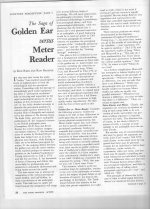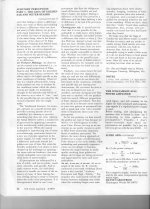Scott, any insight on AD823 vs AD823A?
Die shrink for economic reasons, not directly involved with either. Funny incident when the late James Bongiorno said he couldn't believe a "girl" designed the AD823. Unfortunately he showed up for dinner 4 or 5 sheets to the wind.
One might think so, and it may well be true that in terms of freq response a condensor is more extended, but I find in usage that a good ribbon (which are few) can give a very natural sounding reproduction. As with all this, its a combination of many factors that make up the whole.
Alan
Not talking about nice sounding. talking about resolution and accuracy.
THx-RNMarsh
Let's just say the recorded music oeuvre is a simulacrum bearing little or no resemblance to the live performances, an entity onto itself. That being said there is great enjoyment there.
That s why i listen mainly to live recording, although Denon s jazz recordings are made with musicians playing simultaneaously but still, the eventual mistakes are removed, so it s not that live.
As for the analog/digital debate it seems to me that what is missing in digital recordings is the background noise, despite not being part of the music it still act as some support for the effective information, as if it was a part of the dynamic range, FI i listened to digital content that was re recorded on high quality K7 deck, surprisingly the latter sound warmer because and thanks to the background noise and added distorsion.
Yes, Scott used to be more open about listening, and hi fi upgrades, 30 years ago. I, in those days did call him at home, hoping for a more relaxed conversation that if I called him at work, but I tended to call too late (3hr time difference that I sometimes forgot about) and when he was busy with others. Finally, one night he said he had friends over and that he would not talk to me, so I gave up, finally. Now, there would be no need to exchange information that way.
I'm I don't see what audio/electronics Renaissance was happening in 1985. Ten years later for sure with the vacuum tube reignition.
You are taking a very narrow definition of Renaissance. Certainly for analog lovers during the 80s we had
- The JC Ultramaster tape deck (not sure on exact year but sure John can tell us)
- Shure V15 V5 cartridge
- Ortofon MC2000
- Of course the vendetta phono stage
-SP10 Mk3
There are probably dozens more, and each of them is arguable, as is everything in this weird fetish that is high end audio.
(there is of course another argument that analog peaked in the 70s that is very compelling).
Now some would argue that Analog reproduction actually peak
Those are single products, nothing like a cultural shift.You are taking a very narrow definition of Renaissance. Certainly for analog lovers during the 80s we had
- The JC Ultramaster tape deck (not sure on exact year but sure John can tell us)
- Shure V15 V5 cartridge
- Ortofon MC2000
- Of course the vendetta phono stage
-SP10 Mk3
If you want to use a word not as it is defined then it works.There are probably dozens more, and each of them is arguable,
I'm putting on my captain obvious hat. Just take slew rate and noise. Big strides have been made since the 70's. What do you think the likes of J.C. and S. Wurcer have been doing the last 40 years?(there is of course another argument that analog peaked in the 70s that is very compelling).
Well I am using the definition of renaissance as used to describe the renaissance, where not only were big strides made but we emerged changed, not the one used by hifi reviewers to describe things coming around again.
The lowest noise FETs were available in the 80s*. Now pathologically low output MC carts did die out for 20 odd years so the low noise performance of the JC designs or the electrocompianet were not needed out of that era, but no great strides in low noise audio design have been made in terms of state of the art performance. Cost to get close is a different question.
* every so often a jewel is found, like the BF862.
The lowest noise FETs were available in the 80s*. Now pathologically low output MC carts did die out for 20 odd years so the low noise performance of the JC designs or the electrocompianet were not needed out of that era, but no great strides in low noise audio design have been made in terms of state of the art performance. Cost to get close is a different question.
* every so often a jewel is found, like the BF862.
What about Op amps? Slew rate? Frozen in time since the 70's? Slew induced distortion not much of an issue today.
5534 date from 1975-76, so it wasnt an issue at the time as well, just a question of price..
First you say the 70's, now the 80's, Ok I guess. Moving definitions and parameters to keep an argument afloat.
Nice try, but read what I said. I am not moving the goal posts, but some of the greybeards on here will point out that there were vinyl replay systems in the 70s that have not been surpassed other than by marketing BS.
Now who is changing the goal posts? As Wahab said slew rate wasn't a problem for vinyl in the 80s. For the 3rd time, the lowest noise phono pre-amps produced started life in the 80s. They can now be equaled by the DIY'er, but not really surpassed without transformers. Whether lower noise is needed is another question entirely.What about Op amps? Slew rate? Frozen in time since the 70's? Slew induced distortion not much of an issue today.
Remember Robert, in the late 60's everything had started to go solid state. But it was crap. We had the distortion wars in the 70's, the Japanese hifi invasion, whole mixing desks with 741's plus commercial and DIY stuff (that JC won't let us forget), and RIAA EQ's that were 3and 4 dB adrift until Stanley Lipshitz sorted it out for us in '79. About then, the 5534 came out and by '85 most mixing desks were full of them, CD arrives (ok, not quite perfect sound forever, but convenient, low noise and cheap to produce) and we start going digital.
So, after a c. 15 year detour from a reasonable tube sound in the late 60's, solid state finally starts to get on track. Oh, let's not forget, some decent power output trannies arrived as well, so we could finally ditch those damn 3055's and those quasi-comp OPS's for good.
So, after a c. 15 year detour from a reasonable tube sound in the late 60's, solid state finally starts to get on track. Oh, let's not forget, some decent power output trannies arrived as well, so we could finally ditch those damn 3055's and those quasi-comp OPS's for good.
Last edited:
This falls in line with what I was told about Never hiring theorists at LLNL.
-RNM
That is a limitation I would never accept.
Those who believe it is a "theorist vs experimenter" world are doomed to their own limitations.
That is not my world.
John
Not talking about nice sounding. talking about resolution and accuracy.
THx-RNMarsh
I think he was talking about natural (realistic?) verses what we think should be accurate. It might seem odd if something were accurate, yet unnatural. Suggests the possibility that our models and measurements to determine accuracy might be missing something. We do at least know that large diaphragm condensers can have diaphragm resonance modes at HF. Depending on the resolution of mic frequency response measurements, we might not have a good handle on all the narrow peaks and dips. Some manufacturers might not want to publish unattractive graphs.
That is a limitation I would never accept.
Those who believe it is a "theorist vs experimenter" world are doomed to their own limitations.
That is not my world.
John
Maybe "theorist" was a euphemism for someone not willing to get their hands dirty in the lab? Or, maybe someone not interested in the messy area where mathematical models inadequately or incompletely represent reality?
Last edited:
Maybe "theorist" was a euphemism for someone not willing to get their hands dirty in the lab? Or, maybe someone not interested in the messy area where mathematical models inadequately or incompletely represent reality?
Come on guys this is the Popeye vs. Bluto view of the world of science. Groking the math (theory) at the highest level is a skill few have and they are hired and essential to all these projects. We all work together and in the best case know where to go to eachother for help.
Online Etymology Dictionary
""great period of revival of classical-based art and learning in Europe that began in the fourteenth century," 1840, from French renaissance des lettres, from Old French renaissance, literally "rebirth," usually in a spiritual sense, from renastre "grow anew" (of plants), "be reborn" (Modern French renaître), from Vulgar Latin *renascere, from Latin renasci "be born again, rise again, reappear, be renewed," from re- "again" (see re-) + nasci "be born" (Old Latin gnasci; see genus). "
Some aspect of audio technology has to dwindle down to be dead or nearly so, then come back like a phoenix rising. Op-amps are marching basically upwards. Low noise FETs are having a slow motion hiccup but are hanging on.
In 1985 I know of no audio technology , or aspect of, that was making a comeback.
Four aspects of audio that have made a comeback/renaissance that I know of are all contained in the 90's and the 00's/10's, not mid 80's. The four are DIY and Tubes in the 90's, vinyl and vintage recording studio signal processors in the 00's/10's.
Edit: make that 5. Because of David Royer the ribbon mic also came back. That started in the 90's
""great period of revival of classical-based art and learning in Europe that began in the fourteenth century," 1840, from French renaissance des lettres, from Old French renaissance, literally "rebirth," usually in a spiritual sense, from renastre "grow anew" (of plants), "be reborn" (Modern French renaître), from Vulgar Latin *renascere, from Latin renasci "be born again, rise again, reappear, be renewed," from re- "again" (see re-) + nasci "be born" (Old Latin gnasci; see genus). "
Some aspect of audio technology has to dwindle down to be dead or nearly so, then come back like a phoenix rising. Op-amps are marching basically upwards. Low noise FETs are having a slow motion hiccup but are hanging on.
In 1985 I know of no audio technology , or aspect of, that was making a comeback.
Four aspects of audio that have made a comeback/renaissance that I know of are all contained in the 90's and the 00's/10's, not mid 80's. The four are DIY and Tubes in the 90's, vinyl and vintage recording studio signal processors in the 00's/10's.
Edit: make that 5. Because of David Royer the ribbon mic also came back. That started in the 90's
Last edited:
Very late 80's. It didn't really explode, in the USA, until Nobu Shishido published in Glass Audio in like '91 or something.Robert; tubes, especially SET with direct heated tubes were making a big comeback in the 1980s, along with DIY. I remember, I was in the thick of it.
- Status
- Not open for further replies.
- Home
- Member Areas
- The Lounge
- John Curl's Blowtorch preamplifier part II

